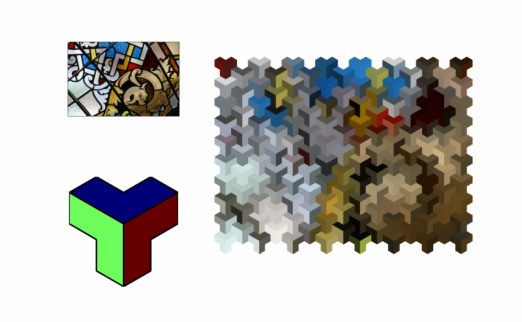I’ve been playing around with the idea of non-square pixels the last couple days (e.g., my Hexagonal Pixel Grids post, or the one on Error Diffusion on Hexagonal Grids). You may have also noticed that I’d switched between hexagons and circles on a few (or even images, like in the post about Tiling on Hex Grids). It doesn’t stop there.
A couple days ago, I came across an image from Interface Digital of a woman pixelated using right triangles (from their post on Triangle Vectorization [originally posted 20110628; since removed]). They created a grid of triangles (on an underlying square grid), and used the image pixel at the center of the triangle to color the shape:
I realized that, yes, this would be a quick and fun code project–and that it wasn’t necessary to limit myself to triangles, either. That’s what this post is about, exploring a few other pixel schemes that were simple to try once the basic framework had been set up.
First, it should be noted that non-square pixels are not new by any means. Andy Gilmore (crowquills.com), the laudenberg/triangle-pixels project (GitHub page), Rev Dan Catt (blog post), pxl (iPhone app), Victor van Gassbeek (Sliced Pixel Project) all came up with minimal searching. Victor Ostromoukhov and Roger Hersch presented a paper, “Artistic Screening”, at SIGGRAPH 1995. I’m sure similar concepts have been used in the art world for a long time. (Perhaps some art history majors could point out a few links via the comments?) So, that all said: this is me playing around for fun. Nothing particularly new.
Each of these examples have three parts. The original picture is in the upper left corner, the pixelated version is on the right half, and the “pixel” is depicted in the lower left corner. Each color is a different subregion of the pixel. I averaged across all the image points under the pixel subregions to find the color.
Without any more ado:
You also don’t have to color within the lines, so long as you respect the neighbor tiles:
A few more non-traditional pixels:
Escher’s famous reptile tessellation block can actually be tiled using a hexagonal base and including three copies of the reptile:
When I first started working on non-square pixels, it was for fun. I saw it as interesting, but not particularly artistic. What I think I’ve found is that the process of pixelating isn’t art (heck, it’s been reduced to science in this case), but selecting the image, a pixel, and all of the details to get the right effect are more challenging. That’s where the art exists.
If you want to see a few more choice examples, I’ve gone ahead and uploaded those for your perusal to a photo hosting site. Follow the link at your convenience.
Finally, here’s one last one for the road, houndstooth:
(Note to self: tileImageArbShape.m)













Thank you for doing this! 😀
It was really interesting to see all the pictures!
Do you know of any equilateral trixel pictures? I’d love to see that compared to square. 🙂